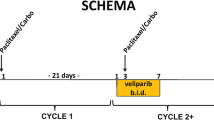Summary
A study was made of the in vivo effects of equitoxic doses of AT-125 and 5-FU combination, being administered either simultaneously (% ILS 152) or with a 6-h pretreatment with AT-125 (% ILS 184). To examine the biochemical basis for the scheduled synergism, measurements were made of the concentration of PRPP, the specific activities of CPS II, cytidine, thymidine, uridine, deoxyuridine kinases, and fluorinated nucleotide formation in P388 tumors and the small intestine. Two hours after in vivo simultaneous treatment of mice bearing tumors the concentration of PRPP increased 9- and 6-fold above baseline in the tumor and the small intestine, respectively. In the AT-125 pretreatment arm the concentration of PRPP increased 18- and 7-fold above baseline in the tumor and the small intestine, respectively. CPS II activity was reduced to 28%–18% of control in the tumors in the simultaneous and pretreatment groups, respectively, whereas it remained unchanged in the small intestine. Specific activities of cytidine kinase (5.5±1), thymidine kinase (4.0±1.6), uridine kinase (35.6±6.5), and deoxyuridine kinase (2.4±1.1) nmol/mg protein/h remained unchanged with treatment. In concert with the increased intratumor concentration of PRPP, fluorinated nucleotide formation was proportionally increased in the treatment arms. These results indicate the importance of drug scheduling of the above two agents in treating P388 leukemia.
Similar content being viewed by others
Abbreviations
- AT:
-
125
- αS,5S:
-
α-amino-3-chloro-4,5-dihydro-5-isoxazoleacetic acid
- 5-FU:
-
5-fluorouracil
- 5-FdUMP:
-
5-fluorodeoxyuridine monophosphate
- PRPP:
-
phosphoribosyl pyrophosphate
- 5-FUMP:
-
5-fluorouridine monophosphate
- 5-FUDP:
-
5-fluorouridine diphosphate
- 5-FUTP:
-
5-fluorouridine triphosphate
- UMP:
-
uridine monophosphate
- UDP:
-
uridine diphosphate
- UTP:
-
uridine triphosphate
- ATP:
-
adenosine triphosphate
- CPS II:
-
carbamylphosphate synthetase II
- PCA:
-
perchloric acid
References
Ardalan B, Cooney DA, MacDonald JS (1980a) Physiological and pharmacological determinants of sensitivity and resistance to 5-fluorouracil in lower animals and man. Adv Pharmacol Chemother 17:289
Ardalan B, MacDonald JS, Cooney DA, Lippman D, Schein P (1980b) In prediction of clinical response to 5-fluorouracil chemotherapy: preliminary results in Cancer Research, Recent Results in Cancer Research (Ed. G. Mathe and F. Muggia) vol. 74, p. 74, Springer Verlag, Heidelberg
Ardalan B, Glazer RI, Kensler TW, Jayaram HN, Pham TV, MacDonald JS, Cooney DA (1981a) Synergistic effect of 5-fluorouracil and N-(phosphonacetyl)-L-Aspartate on cell growth and ribonucleic acid synthesis in a human mammary carcinoma. Biochem Pharmacol 30:2045
Ardalan B, Ayakawa M, Villacorte D, Jayaram HN, Cooney DA (1982) Effect of L-glutamine antagonists on 5-phosphoribosyl-l-pyrophosphate levels P388 leukemia and in murine colon adenocarcinomas in vivo, Biochem Pharmacol 31:1509
Ardalan B, Jayaram HN, Johnson RK (1983) Collateral sensitivity to N-(phosphonacetyl)-L-aspartic acid in a line of P388 leukemia cells selected for resistance to L-(αS, 5S)-α-amino-3-chloro-4,5-dihydro-5-isoxazoleacetic acid (Acivicin). Cancer Res 43:1598
Cadman E, Helmer R, Davis L (1979). Enhanced 5-fluorouracil nucleotide formation after methotrexate administration: explanation for drug synergism. Science 205:1135
Evans RM, Lakshin JD, Hakala MT (1980) Assessment of growth limiting events caused by 5-fluorouracil in mouse cells and in human cells. Cancer Res. 40:4113
Evans RM, Lakshin JD, Hakala MT (1981) Effects of excess folates and deoxyinosine on the activity and site of action of 5-fluorouracil. Cancer Res 41:3288
Hanka LJ, Martin DG, Neil GL (1973) A new antitumor (αS, 5S)-α-amino-3-chloro-4,5-dihydro-5-isoxazoleacetic acid (NSC-163501): antimicrobial reversal studies and preliminary evaluation against L1210 mouse leukemia in vivo. Cancer Chemother Rep 57:141
Heidelberger C (1975). In Sartorelli AC, Johns DG (ed), Fluorinated pyrimidines and their nucleotides: antineoplastic and immunosuppressive agents. (Hdb Exp Pharmacol, Vol. 38, part 2) Springer, New York, p 193
Heidelberger NK, Chaudhuri NK, Danenberg P, Morren D, Griesbach L., Duschinsky R, Schnitzer RJ, Pleven E, Scheiner T (1957). Fluorinated pyrimidines, a new class of tumor-inhibitory compounds. Nature (Lond) 179:663
Houchens D, Ovjera A, Johnson R, Bogden A, Neil G (1977) Therapy of mouse tumors and human tumor xenografts by the antitumor antibiotic AT-125 (NSC-163501). Proc Am Assoc Cancer Res 18:157
Jayaram HN, Cooney DA, Ryan JA, Neil GL, Dion RL, Bono VH (1975) L-(αS, 5S)-α-amino-3-chloro-4,5-dihydro-5-isoxazoleacetic acid (NSC 163501): a new amino acid antibiotic with the properties of an antagonist of L-Glutamine. Cancer Chemother Rep 59:481
Kensler TW, Multler G, Hankerson JG, Reek LJ, Harley C, Han N, Ardalan B, Cysyk RL, Johnson RK, Jayaram HN, Cooney DA (1981). Mechanism of resistance of variants of the Lewis lung carcinoma to N-(Phosphonacetyl)-L-aspartic acid. Cancer Res 41:849
Kessel D (1980) Cell surface alterations associated with exposure of leukemia L1210 cells to fluorouracil. Cancer Res 40: 322
Kufe DW, Egan EM (1981). Enhancement of 5-fluorouracil incorporation into human lymphoblast ribonucleic acid. Biochem. Pharmacol. 30:129
Maybaum J, Ullman B, Mandel HG, Day JL, Sadee W (1980) Regulation of RNA-and DNA-directed actions of 5-fluoropyrimidines in mouse T-lymphoma (S-49) cells. Cancer Res 40:4209
Myers CE (1981) The pharmacology of the fluoropyrimidines. Pharmacol Rev 33:1
Neil GL, Berger AE, McPartland RP, Grindey GB, Bloch A (1979). Biochemical and pharmacological effects of the fermentation-derived antitumour agent (αS-5S)-α-amino-3-chloro-4,5-dihydroisoxazoleacetic acid AT-125. Cander Res 39:852
Spiegelman S, Sawyer R, Nayak R, Ritzi E, Stolfi R, Martin D (1980). Improving the antitumor activity of 5-fluorouracil by increasing its incorporation into RNA via metabolic modulation. Proc Natl Acad Sci USA 77:4966
Tax WJM, Veerkamp JH (1977). A simple and sensitive method for estimating the concentration and synthesis of 5-phosphoribosyl l-pyrophosphate in red blood cells. Clin Chem Acta 78:209
Author information
Authors and Affiliations
Rights and permissions
About this article
Cite this article
Ardalan, B., Chandrasekaran, B. & Hrishikeshavan, H.J. Biochemical mechanisms for the scheduled synergism of (αS, 5S)-2 amino-3-chloro-4,5-dihydro-5-isoxazoleacetic acid and 5-fluorouracil in P388 leukemia. Cancer Chemother. Pharmacol. 15, 44–48 (1985). https://doi.org/10.1007/BF00257293
Received:
Accepted:
Issue Date:
DOI: https://doi.org/10.1007/BF00257293




